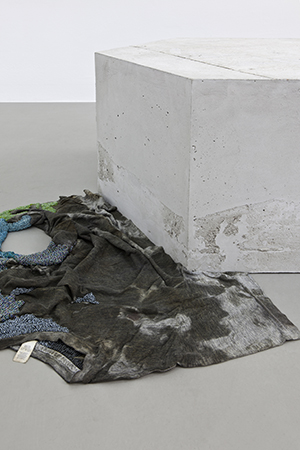Isa Melsheimer:
Examination of the Origins
February 28–April 28, 2015
Opening: February 28, 7pm
Quartz Studio
Via Giulia di Barolo, 18/D
10124 Turin
Italy
T +39 338 4290085
F +39 011 8264640
info@quartzstudio.net
On Saturday, February 28, at 7pm, Quartz Studio is delighted to introduce the exhibition Examination of the Origins, the first solo show in Italy by the German artist Isa Melsheimer (b. 1968; Neuss, Germany). Melsheimer has made a site-specific installation for the occasion. The installation’s sculptural elements were conceived based on the features of Quartz’s space, juxtaposed with the architectural shapes of some of Turin’s buildings.
Melsheimer explains: “The idea behind the title is my interest in some of Turin’s housing. My interest focuses on twentieth-century Italian architecture, the coexistence of Rationalism, the Novecento and the Roman School during Fascism. I am also interested in their continuation to the 1960s, joining with new influences, such as Frank Lloyd Wright’s Organic Architecture from the United States. Another inspiration in developing the project was Quartz’s space, especially its floor and its hexagonal tiles.”
Twentieth-century Italian architecture is a springboard for Melsheimer’s personal reflection, starting from several buildings that were key parts of architectural design in Turin and Milan in the 1950s and 1960s. She particularly focused on several famed buildings, such as the Velasca Tower by Studio BBPR in Milan, which preserves an aesthetic sense of the medieval city; the INA-Case Falchera housing district; the Bottega d’Erasmo by Gabetti and Isola, which brings back the tradition from the early 20th century in Turin and was termed neo-Liberty style; the Palazzo del Lavoro by Pier Luigi Nervi, a spectacular example of the architect’s “structuralism;” and the innovative Palazzo delle Mostre (PalaVela), designed by the engineer Franco Levi and architects Annibale and Giorgio Rigotti. Then there are two lesser-known buildings by Enzo Venturelli, which are fascinating for their originality: the home/studio of the sculptor Umberto Mastroianni and the aquarium-reptile house in the zoo, for which Venturelli coined the terms Architecture for the nuclear age or Atomic architecture. The architecture accomplishments achieved in Turin in the mid-20th century are a natural outgrowth of its cultural vibrancy, bolstered by its industrial development and figures the likes of Lionello Venturi, Edoardo Persico and Riccardo Gualino. After World War II, Turin was much more about opening to Europe, compared to Rome, buried in its classicism or Milan, which had become an expression of 20th-century architects’ “return to order.” Italian Neorealism, most firmly established in literature and film, also made its influence felt in architecture, fostering a return to “roots” based on drawing from local traditions and construction techniques, which moved away from Rationalism.
As Melsheimer noted, in Italy, more than anywhere else, the attempt to go beyond the modern movement took off in a multiplicity of directions with different inspirations, often with contrasting results, and was not always warmly welcomed by contemporary critics. The artist stitches the narrative of this special period in Turin architecture into images on the fabric of a curtain hanging from the ceiling to the floor and covering part of the cement tile floor. Several cement and ceramic sculptures are placed on the curtain on the ground, popping up all about like in a winter garden. These simple, minimalist structures are designed based on the hexagonal shape of the cement tiles, a common feature in Italy on floors between the late 19th and early 20th centuries. Melsheimer has long been interested in architecture and landscape as a whole. Here she again turns the tangible quality and power of built forms into a delicate, unstable installation, with minimalist embroidered designs and small sculptural forms closely connected to one another. The curtain drops from above down to the floor, softening the right-angled opposition between the vertical wall and horizontal floor. This makes for a unique installation that imperceptibly transforms the space. The artist starts from the geometry of the cement tiles on the floor and conceptually opens Quartz’s walls as she extends her gaze to Turin’s urban and architectural history with its many extraordinary buildings—many of which have fallen into disuse or been inexplicably forgotten.
After Melsheimer’s studies at the Hochschule der Künste in Berlin, she lived and worked, thanks to scholarships and artist residences, in Marfa, Texas; Los Angeles; Istanbul; Lisbon; and Rome. In her sculptures and installations, Melsheimer repeatedly refers to architecture, urbanism and landscaping. The form of expression with which she discusses mostly uninhabited or endangered situations is often linked to the perpetual change in scale and perspective.
Isa Melsheimer is represented by the galleries of Esther Schipper (Berlin), Jocelyn Wolff (Paris) and Nächst St. Stephan (Vienna). Important exhibitions took place at the Bonnefanten Museum in Maastricht, Netherlands (2004); Carré d’art – musée d’art contemporain, Nîmes, France (2010); the Museum of Art, Santa Monica, Los Angeles, USA (2012); the IKOB – Museum of Contemporary Art in Eupen, Belgium (2014); and the Barlach Haus, Hamburg, Germany (2015). Her works have been exhibited in the following public collections: S.M.A.K. Stedelijk Museum voor Actuele Kunst, Gent; Europäisches Patentamt, München; Bonnefanten Museum, Maastricht; Museum Ludwig, Köln; Sammlung der Deutschen Bank, Frankfurt; Künstlerhaus Schloss Balmoral, Stiftung Rheinland-Pfalz, Bad Ems; Arp Museum Bahnhof Rolandseck; Carré d’art – Musée d’art contemporain de Nîmes; MUDAM, Luxembourg; CNAP Centre national des arts plastiques, France.
We would like to thank the artist and the gallery Ester Shipper for the kind cooperation. The exhibition will run from February 28 to April 28, by appointment.
